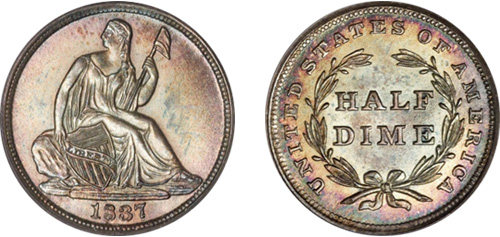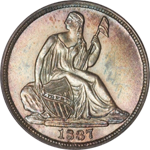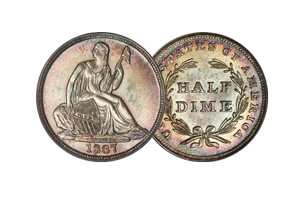The Seated Liberty half dime is a U.S. silver coin that was minted from 1837 to 1873. The first silver half dime was produced in 1792 by the U.S. Mint, the “1792 half disme”, followed by the Draped Bust and the Capped Bust half dime. The Seated Liberty half dime was introduced in 1837 and it was also the last silver half dime to be produced in the U.S. Even though the face value of the coin is five cents, it should not be confused with five-cent pieces made of base metals commonly called “nickels.” The first U.S. nickel, called the Shield nickel, was actually 75 percent copper and 25 percent nickel and originally struck in 1866.
New steam technology and large silver and gold supplies (due to the revolutionary wars in Latin America) allowed the U.S. Government to vast amounts of coins in a quick and efficient manner by the early 1830s. Mint Director Robert M. Patterson commissioned several engravers and artists to develop a design containing the Liberty for the silver dollar, until newly appointed Christian Gobrecht produced the final version in 1935. The Seated Liberty design was consequently adapted for half dimes and dimes in 1937. The Mint first issued approximately 20 proofs for presentation, of which 12 to 14 are known today. These proof coins are different from business strikes in that they have particularly bold detail and fully reflective surfaces. A total of 1,405,000 Seated Liberty half dimes were struck in that year.

Gobrecht’s original design can only be found on half dimes (and dimes) struck from 1837 to 1838. The obverse side of any coin in the Seated Liberty series features Lady Liberty seated on a large rock. She holds a liberty pole with a Phrygian cap on top, a symbol of freedom. Her other hand holds the top of a shield that has LIBERTY stamped across it diagonally on a banner, with the shield representing the willingness to defend freedom. The date is stamped below the rock. On the reverse, the large inscription HALF DIME is located in the center, and a wreath surrounds the denomination.
The mintmark’s location depends upon the year; prior to 1860, mintmarks were engraved inside the wreath, while they were placed below the wreath near the coin’s rim afterwards. As is typical with U.S. coins, the lack of a mintmark means that the coin was struck in Philadelphia. Other mintmarks for the Seated Liberty half dime are O, S, and CC for New Orleans, San Francisco, and Carson City, respectively.
The Seated Liberty half dimes consist of 90% silver and 10% cooper.
Interestingly enough, the Seated Liberty half dime actually comes in different types and varieties. These subtle variances can range from a mintmark’s position to a repunched date to a different dye. Today, some collectors try to assemble complete sets, but many focus on the search for different varieties. In the first year of production, there were no stars across the top of the obverse. From 1837 until 1859, thirteen stars circled the image of Liberty, creating the Stars Obverse type. In 1853, the Mint introduced fiduciary coinage, changing the weight of silver coins, and marked these Seated Liberty coins with arrows on each side of the date. The stars were eventually replaced with the legend UNITED STATES OF AMERICA in 1860. This is probably because the wreath on the reverse got a lot more elaborate in 1859. In 1859 and part of 1860, the United States of America was left off the half dime, and then it began to replace the 13 stars on the obverse in 1860.
While the Seated Liberty half dime was in wide circulation before the Civil War, mintages declined during the war due to the economic upheaval, the coin was discontinued a few years later. The Coinage Act of 1973 changed the weights of the dime, quarter dollar and half dollar to conform to the metric systems, and it also ended the production of a number of denominations, including the half dime. The five-cent coin was replaced by the copper-nickel piece we know today.
Seated Liberty half dimes, and the entire Seated Liberty series of coins, are popular with collectors who enjoy a lot of variety. There are different types and several varieties within some of these types. Since the Civil War disrupted production, many later examples of this coin are quite rare and valuable. For instance, the 1838 H10C Large Stars, No Drapery MS68 Seated Liberty sold for $37,375, and the 1854-O H10C Arrows MS67 was purchased for $32,200. Note that Seated Liberty coins cannot be included in an Individual Retirement Account, as their worth is based on their numismatic value rather than the value of their precious metal content. Still, these historically significant coins are coveted by collectors and investors alike, as they can generate a substantial profit.


